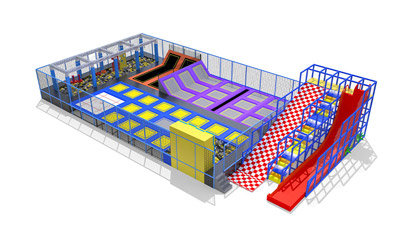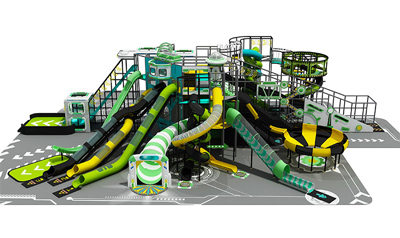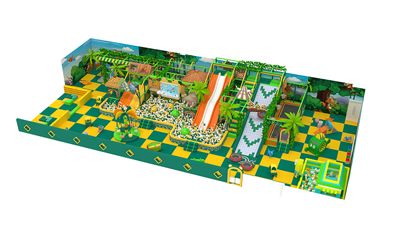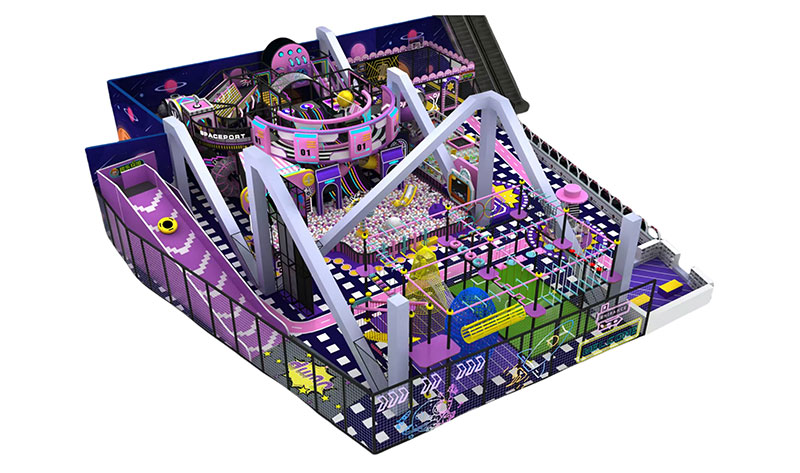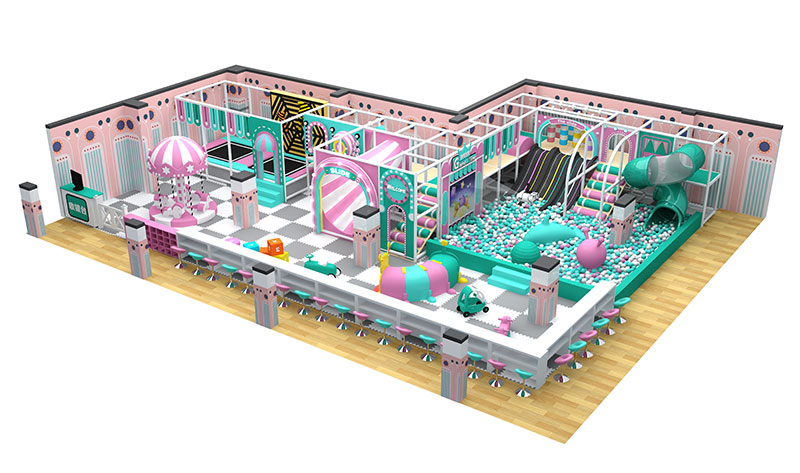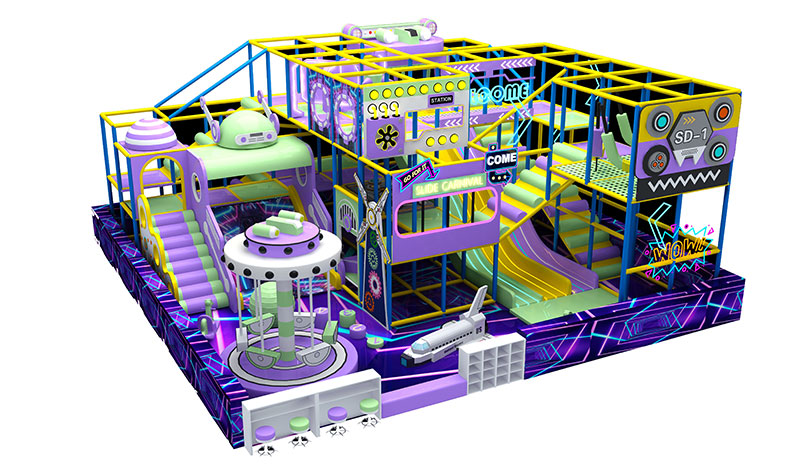Transforming your backyard or indoor playground into a children's playground is a fun and rewarding project that can provide children with a safe and exciting space to play and explore. Here is a step-by-step guide to help you transform your backyard or indoor playground into a fantastic play area:
1. Assess the Space
Measure the Area: Before beginning, measure the size of your backyard to determine how much space you have to work with.
Check for Hazards: Look for any existing hazards like sharp objects, toxic plants, uneven ground, or obstacles that might need to be addressed before kids can safely play.
Plan for Safety: Ensure the area is childproof, keeping in mind that you'll need to make room for play equipment, seating, and pathways.
2. Define Play Zones
· Separate Play Areas: If you have a large backyard, consider creating distinct zones. For example:
A climbing and sliding area with a jungle gym, slides, and swings.
A sandbox or digging area for creative play.
A quiet zone for reading or relaxing.
· Age Appropriateness: Think about your child’s age. Smaller children will need more space for crawling and rolling, while older kids may enjoy climbing and swinging.
3. Choose Kid-Friendly Play Equipment
Consider adding some of the following features, depending on your space and budget:
Swings: A classic swing set is always a favorite. Choose a sturdy one made of durable materials.
Slide: A slide can be attached to a play structure or used as a standalone feature.
Jungle Gym or Climbing Structure: Great for encouraging physical activity and developing motor skills.
Sandbox: A large, covered sandbox can be a fun creative space. Fill it with safe, non-toxic sand.
Trampoline: A smaller, safety-ensured trampoline can provide hours of fun.
Tire Swing: If you want something a little different, consider a tire swing for a fun, nostalgic play experience.
Balance Beam or Rope Bridge: These features help children develop balance and coordination.
4. Safety First
· Ground Surface: Install a soft surface to cushion falls. Options include:
* Mulch: Rubber mulch or wood chips are great options that offer a soft landing and are non-toxic.
* Artificial Turf: This provides a clean, cushioned play surface.
* Rubber Mats: These can be placed under slides or swings to reduce impact from falls.
· Fencing: If your backyard isn’t already fenced, consider installing one to prevent children from running into the street or getting into dangerous areas like pools or gardens.
· Smooth Edges: Make sure any sharp edges on playground equipment, fences, or structures are covered with protective padding.
5. Add Creative Play Elements
Water Play Area: A small water table, sprinkler, or even a kiddie pool can be a great addition, especially in the summer.
Art and Craft Corner: Set up an outdoor chalkboard or easel, or create an area for kids to engage in outdoor arts and crafts.
Interactive Features: Install a musical wall, with chimes or drums, or create a space for hide-and-seek with large cardboard boxes or tents.
Garden Space: Create a small garden where children can plant flowers or vegetables. Gardening can be a fun and educational activity.
6. Seating and Shade
· Benches or Outdoor Seating: Include some benches or lounge chairs for parents or caregivers to sit and supervise.
· Shade: Add shade to protect kids from the sun. This can be done using:
- Awnings or Pergolas.
- Shade Sails.
- Tree Canopies if you have large trees in your yard.
7. Decorate and Personalize
- Bright Colors: Use colorful toys, structures, and furniture to make the space feel more vibrant and inviting.
- Theme: Choose a theme for the play area, such as a pirate ship, castle, or jungle adventure, and decorate accordingly.
- DIY Projects: You can create your own fun play elements, like painted stepping stones, a chalkboard wall, or a wooden climbing wall.
8. Maintain the Playground
- Regular Inspections: Check all equipment regularly to make sure it’s in good working order, safe, and secure.
- Cleaning: Keep the area clean, especially sandboxes and water features.
- Safety Gear: Ensure any play equipment that requires safety gear, like helmets for biking or scooters, is available.
9. Consider Eco-Friendly Features
- Recycled Materials: Use recycled materials for things like sandboxes, climbing structures, or pathways.
- Sustainable Landscaping: Consider planting native, non-toxic plants that are safe for children and beneficial to the environment.
- Solar Lighting: Install solar-powered lights for evening playtime, or to create a fun ambiance during evening gatherings.
10. Involve Your Kids
- Let Them Have a Say: Get your kids involved in the design process. Ask them what they’d like in their playground, whether it’s a specific type of swing, slide, or even a theme.
- Test the Equipment: Once everything is set up, allow your kids to play on the equipment and see if it needs adjustments. Their feedback can help ensure the playground is both fun and functional.
Indoor play equipment recommendation
After designing the outdoor children's play area, indoor play equipment is also a very worthy supplement to consider, especially when the weather is bad or night falls, the indoor playground equipment can provide continuous entertainment and exercise opportunities. The following are some play equipment suitable for indoor use, which can keep children active and happy at home.
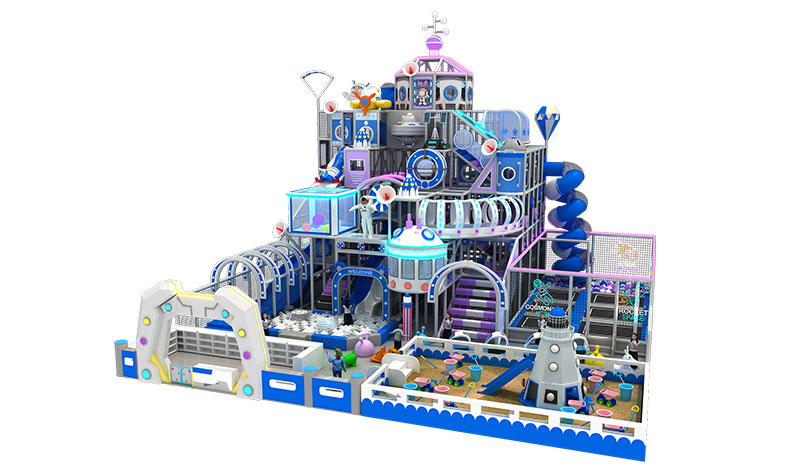
1. Indoor slide
Small slide: Indoor slides are usually smaller and lower than outdoor slides, suitable for use in living rooms, bedrooms or playrooms. They are mostly made of soft materials to prevent children from falling. You can choose a combination with steep slopes and gentle slopes to increase the diversity of sliding.
Slide combined with ladder: This design has both a slide and a ladder for children to climb, which can exercise children's hand and foot coordination.
2. Indoor trampoline
Trampoline Parks: Trampoline parks usually contain multiple large trampoline areas for children to jump and play indoors. The trampoline equipment in these parks is usually designed with safety guardrails to ensure the safety of children while jumping. In addition to allowing children to release excess energy, trampolines can also effectively improve their sense of balance and athletic ability. It is not only a fun place to entertain, but also a great choice to help children exercise and improve coordination.
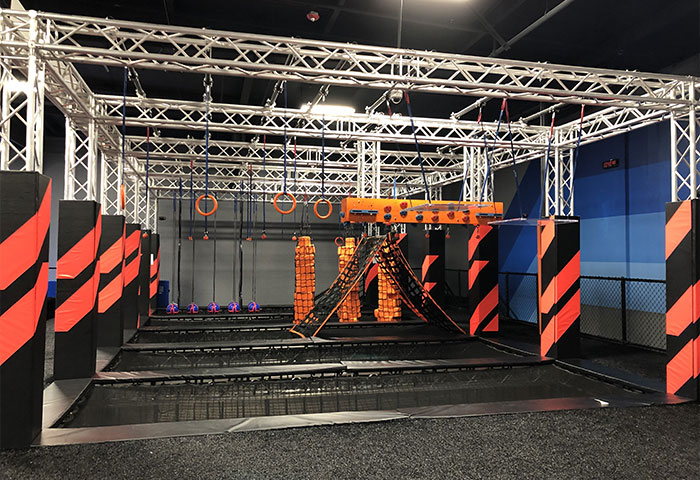
3. Indoor climbing frame
Multi-function climbing frame: This equipment is usually made of wood, steel pipe or plastic, combining multiple elements such as slides, ropes, ladders, etc. Children can climb and challenge at home to help improve their strength and endurance.
Hanging climbing frame: Suitable for smaller spaces, it can be hung on the door frame or wall to provide more climbing and hanging functions.
4. Indoor swing
Family swing: To increase the fun of children's indoor activities, a small swing can be installed on the ceiling or door frame. Swings not only help children relax, but also promote their forward and backward swinging movements and exercise core muscles.
Swing chair or hammock: If space is limited, you can choose a smaller swing chair or hammock, which can also bring children a pleasant feeling.
5. Indoor ball pool
Inflatable ball pool: This ball pool is usually made of soft materials and can accommodate a large number of colorful balls, where children can play, roll and jump. The ball pool helps children's tactile development and sensory stimulation, and is also a safe "activity area".
Convenient storage: Many ball pool designs can be folded for easy storage when not in use.
6. Padded puzzles
Puzzle mats: This patchwork cushion can cover the entire indoor area, providing a comfortable surface for children and can also be used for various games. The colorful patterns of the puzzles can attract children's attention and stimulate their creativity.
Multifunctional design: Some puzzle mats also combine elements such as numbers and letters to achieve early education in play.
7. Indoor sports equipment
Mini fitness equipment: such as mini treadmills, steppers, skipping ropes, etc., can allow children to do simple exercises indoors and stay active. Many equipment are simple and safe for children.
Small yoga mats: Suitable for yoga or physical training, especially for families with multiple children. Children can imitate their parents or do simple yoga and stretching.
8. Indoor creative toy area
Toy blocks: Multifunctional assembly toys such as Lego blocks can not only help children exercise their hands-on skills, but also stimulate their creativity and imagination.
Drawing wall or tabletop: Design a small drawing area or creative table where children can doodle, paint, and use their artistic talents. Use wipeable paint and wall paper to make cleaning easier.
9. Children's tents and playhouses
Tents or huts: Children's tents, tent huts or mini castles provide children with a private small space where they can play games, read or rest. Tent designs are usually soft and easy to build, suitable for indoor use.
Play kitchen or store: This small simulated kitchen or store toy equipment allows children to simulate adult life and exercise their social skills, role-playing and imagination.
10. Interactive projection games
Projectors and interactive floor games: Some high-tech projection equipment can project games onto the ground or wall. Children can interact by touching or stepping on the patterns on the screen, which not only increases the amount of exercise, but also allows children to enjoy a novel experience.
Safety tips:
Environmentally friendly material selection: Make sure all indoor equipment and toys use non-toxic, environmentally friendly materials and do not contain harmful substances.
Avoid sharp corners and hard objects: Check all equipment to ensure that there are no sharp edges or fragile parts.
Age-appropriate design: Choose equipment that matches your child’s age group and ensure that the height, strength, and functionality of the equipment are appropriate for your child.
Conclusion:
By adding play equipment suitable for indoor use, you can create a fun and active space for your children, ensuring that they are fully entertained and physically active whether it is winter or rainy. Outdoors, with a little creativity, planning, and safety, you can turn your backyard into a magical playground where children can run, jump, climb, and explore. This not only provides children with abundant physical activities, but also stimulates their intelligence and brings hours of fun. Whether indoors or outdoors, a well-designed play area will become an invaluable memory for children as they grow up.


